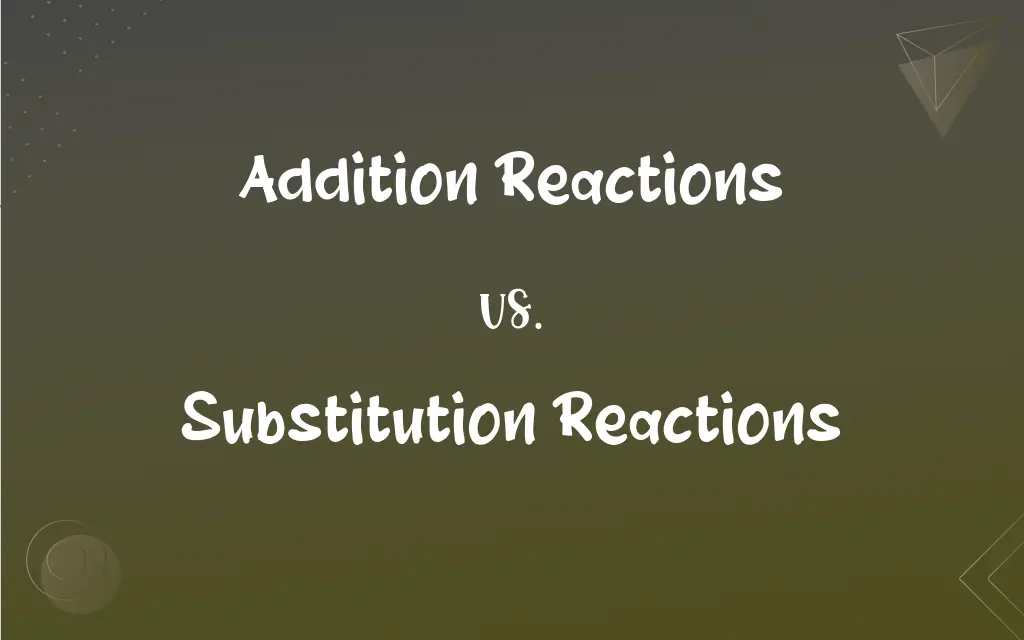Addition Reactions vs. Substitution Reactions: What's the Difference?
Edited by Aimie Carlson || By Harlon Moss || Updated on October 24, 2023
Addition reactions involve molecules combining without loss of atoms, while substitution reactions replace one atom/group with another in a molecule.

Key Differences
Addition reactions are chemical processes where two or more molecules combine to form a larger single molecule, with no atoms being lost in the process. On the other hand, substitution reactions involve a scenario where one atom or group in a molecule is replaced by another atom or group.
Observing addition reactions, one would typically notice the total number of atoms in the reactants being equal to the number of atoms in the product. In contrast, substitution reactions often demonstrate the exchange of parts, where something in the initial molecule is swapped out for something else.
When considering the implications, addition reactions are common in unsaturated organic compounds like alkenes and alkynes, where pi bonds can be broken to accommodate new atoms. Substitution reactions, in contrast, are prevalent in molecules like alkanes, where a hydrogen atom, for instance, might be replaced by a halogen.
Comparison Chart
Type of Reaction
Combines molecules without atom loss.
Replaces one atom/group with another.
Reactant/Product Relation
Atoms in reactants = Atoms in products.
Exchange of parts in molecules.
ADVERTISEMENT
Common Organic Participants
Unsaturated compounds (alkenes, alkynes).
Saturated compounds (alkanes).
Bonds Involved
Breaks pi bonds.
Often involves breaking and forming sigma bonds.
Overall Result
Increases molecule size.
Molecule size remains consistent, parts change.
Addition Reactions and Substitution Reactions Definitions
Addition Reactions
Involve breaking pi bonds to accommodate new atoms.
In the presence of a catalyst, alkynes undergo addition reactions with hydrogen.
Substitution Reactions
The overall molecule's size remains consistent, but parts within it change.
When ethanol reacts with hydrogen iodide, it undergoes substitution reactions, producing ethyl iodide.
ADVERTISEMENT
Addition Reactions
Lead to an increase in the size of the resultant molecule.
When hydrogen chloride reacts with ethene, it showcases addition reactions, resulting in chloroethane.
Substitution Reactions
Commonly seen in saturated organic compounds.
Alkanes, due to their single bonds, can undergo halogenation through substitution reactions.
Addition Reactions
Chemical processes where molecules combine to form a larger molecule.
The reaction of ethene with hydrogen is an example of addition reactions, producing ethane.
Substitution Reactions
Chemical processes where one atom/group in a molecule is replaced by another.
Chlorination of methane in the presence of sunlight is an example of substitution reactions.
Addition Reactions
Occur commonly in unsaturated organic compounds.
Alkenes, due to their double bonds, undergo addition reactions with halogens.
Substitution Reactions
Often involve breaking and forming sigma bonds.
In the presence of UV light, chlorination of methane showcases substitution reactions.
Addition Reactions
Reactions where no atoms are lost during the process.
Bromine water turning colorless when added to propene demonstrates addition reactions.
Substitution Reactions
Involves the exchange of parts in a molecule.
The reaction of bromine with methane, producing methyl bromide, highlights substitution reactions.
FAQs
Do addition reactions break bonds?
Yes, particularly pi bonds in unsaturated compounds like alkenes and alkynes.
What's a classic example of substitution reactions?
The halogenation of alkanes, like the chlorination of methane, is a classic example.
What are addition reactions?
Addition reactions are where molecules combine to form a larger molecule without losing any atoms.
Why are addition reactions significant in polymer science?
Addition reactions, especially involving unsaturated monomers, are key to forming long-chain polymers.
How do substitution reactions differ from addition reactions?
Substitution reactions replace one atom or group in a molecule with another, whereas addition reactions combine molecules without atom loss.
Are addition reactions limited to organic chemistry?
While common in organic chemistry, addition reactions can also occur in inorganic systems.
What kind of bonds are typically broken in substitution reactions?
Sigma bonds are often broken and formed in substitution reactions.
Are there limitations on the groups added in addition reactions?
It depends on the reactivity and structure of the molecules involved, but there are typical groups like halogens or hydrogen that are added.
What determines if an organic compound undergoes addition reactions?
The presence of double or triple bonds, as in alkenes or alkynes, often leads to addition reactions.
How do substitution reactions affect the structure of a molecule?
They change a part of the molecule by replacing one atom or group with another.
What's a real-life application of addition reactions?
The polymerization of ethene to form polyethene is an industrial application of addition reactions.
What drives substitution reactions in alkanes?
Substitution reactions in alkanes are often driven by the presence of halogens and UV light.
Are addition reactions endothermic or exothermic?
It varies, but many addition reactions, like the addition of hydrogen to alkenes, are exothermic.
Can a compound undergo both addition and substitution reactions?
Yes, depending on its structure and the conditions, a compound can participate in both types of reactions.
Are there safety concerns with either reaction type?
As with all chemical reactions, safety concerns depend on the reactants and products; it's crucial to understand the materials and conditions involved.
Do substitution reactions always involve halogens?
No, while halogenation is common, substitution reactions can involve other groups too.
Is there a specific catalyst needed for substitution reactions?
It depends on the reaction, but some require a catalyst or specific conditions like UV light.
How does molecule size change in addition reactions?
In addition reactions, the molecule size typically increases as reactants combine.
Can a single molecule undergo multiple substitution reactions?
Yes, depending on its structure, a molecule like methane can undergo multiple substitutions, leading to compounds like dichloromethane.
Can substitution reactions be reversed?
Some can be, depending on the conditions and reactants, but it often requires specific catalysts or conditions.
About Author
Written by
Harlon MossHarlon is a seasoned quality moderator and accomplished content writer for Difference Wiki. An alumnus of the prestigious University of California, he earned his degree in Computer Science. Leveraging his academic background, Harlon brings a meticulous and informed perspective to his work, ensuring content accuracy and excellence.
Edited by
Aimie CarlsonAimie Carlson, holding a master's degree in English literature, is a fervent English language enthusiast. She lends her writing talents to Difference Wiki, a prominent website that specializes in comparisons, offering readers insightful analyses that both captivate and inform.































































